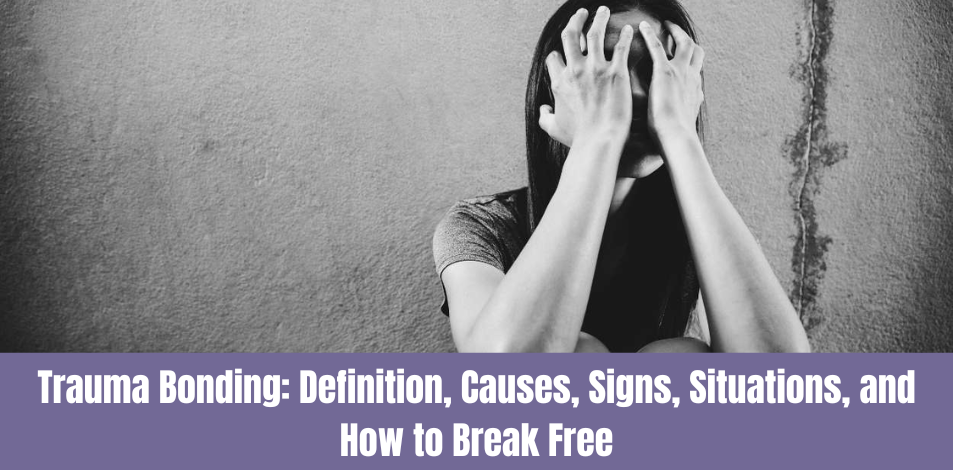
Wondering what’s trauma bonding? Are you or a loved one in a toxic or abusive relationship? But you can’t break free from this relationship?
I’m torn…to learn more about your relationship dynamics. This confusion about your feelings hurts me. But I’m so glad I made this thought piece… and so proud that you’re searching for happiness.
With this thought, let me soothe every corner of your heart… and together we step toward the light at the end of this dark tunnel.
So, hold my hand tight…and don’t let go, because I want you to be happy.
Let’s get to the brighter side together, let’s get started…
Trauma Bonding Infographics
What is trauma bonding? (Trauma bonding explained)
In relationships characterized by recurring patterns of abuse, when the abused person makes excuses for their abuser’s behavior…this is called “trauma attachment.”
The victim of abuse feels an emotional connection to his or her offender. This is usually due to an endless cycle of abuse and positive emotions.
The attacker says it is because he loves the victim, apologizes, shows signs of remorse and kindness, and tries to win the victim over.
On the other hand, the victim notices their efforts and believes they were unintentional. A trauma bond develops when the abuser successfully manipulates the victim.
Positive reinforcements confuse the victim. It makes it difficult for them to break free from abusive relationships.
Related : Narcissist and Codependent: The Toxic Relationship
In general, trauma bonding feels like a compulsive cycle of tiptoeing into the relationship. The victim does not want to provoke the attacker’s unintended offense, so he always tries to please him.
However, it again leads to physical, emotional, mental or verbal abuse.
But never assume that all victims of abuse develop trauma bonds. It may take a few days to a few years for victims to develop emotional attachments to their abuser.
However, many people misunderstand this concept. So, let’s find out…
What trauma bonding is not?
Trauma bonding is part of an unhealthy relationship. But some people misunderstand and romanticize the concept of trauma bonding.
They feel it is the relationship between two people who have experienced the same or similar trauma. Some define it as people fighting difficulties together.
Related : Narcissist: Recognizing & Living with NPD
People assume it’s a form of romantic relationship just from the name. In this world, 25% of women and 10% of men are victims of violence in intimate relationships.
Examples of the interconnectedness of shocks
Trauma bonding can occur between married or unmarried couples, friends, parent-child relationships, or even between a criminal such as a human trafficker or kidnapper and their victims. It doesn’t just end with romance.
So, let’s know the broad prospects here…
- Marriage trauma
A husband abused his wife for years. When she contacts her parents, they say that they are not their family anymore, but her husband. With this thought, she lives by blaming herself for the abuse.
She tells her counselor that she deserves to be mistreated because she is not the best wife.
- Parental trauma
Sometimes parents compare their children with others and insult them. Even if their child gets a 99/100, the parents beat him physically and emotionally because he did not get a 100.
The child feels exhausted but thinks this is for the best. Because that’s how he scored best.
- Trauma bonding friendship
A group of girls bullying another girl. They tell her that they are her friends so she must follow their instructions to maintain the friendship. The girl accepts abuse to have friends and feel lucky.
At least people hang out with me”…she thinks.
- Human trafficking relational trauma
A human trafficker kidnaps a woman. He abuses her every day. One day, he shared his past and how he became one and treated her well. The woman feels an emotional connection to her captor.
She justifies her captor’s decisions. This is also called Stockholm Syndrome. This was the most commonly used term before trauma correlation.
- Interconnection with trauma
There are two people in a relationship but they do not have money. Person A asks Person B to earn money in exchange for sex. B thinks A is a genius for saving them from starvation so quickly.
However, B never wanted to do this. B wants to break up but feels guilty for hurting A.
So, let’s get a rough idea of such relationships here…
What is the trauma bond relationship?
In a trauma relationship, one person abuses the other unless they follow certain rules. If the other person becomes obedient, he rewards him.
However, even after being obedient, they will not treat the victim well forever. The abuser is always looking for flaws in the victims and the cycle continues.




